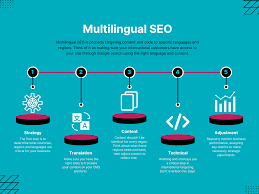The Power of Multilingual SEO: Reaching Global Audiences
In today’s interconnected world, businesses are no longer confined by borders. The internet has opened up a world of opportunities for reaching global audiences, but to truly capitalise on this potential, multilingual search engine optimisation (SEO) is essential.
What exactly is multilingual SEO? Simply put, it involves optimising your website and online content for multiple languages and regions. By tailoring your SEO strategy to different languages and cultures, you can enhance your visibility in international search engine results pages (SERPs) and attract a diverse range of visitors.
The Benefits of Multilingual SEO
Expanded Reach: By targeting keywords in multiple languages, you can reach a wider audience across the globe. This opens up new markets and opportunities for growth.
Improved User Experience: When users can access your website in their preferred language, they are more likely to engage with your content and stay on your site longer.
Enhanced Credibility: A multilingual website signals to visitors that you are a global player who values diversity and inclusivity. This can boost your credibility and trustworthiness in the eyes of international audiences.
Key Strategies for Multilingual SEO Success
To make the most of multilingual SEO, consider implementing the following strategies:
- Keyword Research: Conduct keyword research in each target language to identify relevant terms and phrases that resonate with local audiences.
- Hreflang Tags: Implement hreflang tags to indicate to search engines which language version of a page should be served to users based on their location or language preference.
- Cultural Sensitivity: Take into account cultural nuances and preferences when localising content for different regions. What works in one market may not necessarily work in another.
- Quality Translation: Invest in professional translation services to ensure that your content is accurately translated without losing its original meaning or intent.
In Conclusion
Multilingual SEO is not just about translating keywords; it’s about creating a seamless user experience for an international audience. By embracing multilingual SEO best practices, you can position your business for success on the global stage and connect with customers from diverse backgrounds.
If you’re looking to expand your online presence beyond borders, multilingual SEO is a powerful tool that can help you unlock new opportunities and drive sustainable growth. Start thinking globally with multilingual SEO today!
Essential FAQs on Multilingual SEO: Understanding, Benefits, Challenges, and Implementation
- What is multilingual SEO and why is it important?
- How does multilingual SEO differ from traditional SEO?
- What are the key benefits of implementing multilingual SEO?
- What are some common challenges faced in multilingual SEO?
- How can I effectively implement a multilingual SEO strategy for my website?
What is multilingual SEO and why is it important?
Multilingual SEO refers to the practice of optimising a website and its content to target multiple languages and regions, thereby improving its visibility in international search engine results. This strategy is crucial for businesses looking to expand their reach beyond their native language and tap into global markets. By implementing multilingual SEO techniques, businesses can attract a diverse range of audiences, enhance user experience by providing content in users’ preferred languages, and establish credibility as a global player. Ultimately, multilingual SEO enables businesses to connect with international customers effectively and drive growth in new markets.
How does multilingual SEO differ from traditional SEO?
When comparing multilingual SEO to traditional SEO, the key difference lies in the focus on targeting multiple languages and regions rather than just a single language or market. Multilingual SEO involves optimising content for different languages, cultures, and search engines to reach a diverse global audience. This approach requires specific strategies such as keyword research in multiple languages, implementation of hreflang tags to indicate language variations, and consideration of cultural nuances in content localisation. In essence, multilingual SEO expands the scope of traditional SEO by catering to international audiences and enhancing user experience across various linguistic landscapes.
What are the key benefits of implementing multilingual SEO?
Implementing multilingual SEO offers a range of key benefits for businesses looking to expand their online reach and connect with global audiences. By optimising your website for multiple languages, you can significantly increase your visibility in international search engine results pages (SERPs), attracting a diverse array of visitors from different regions. This expanded reach not only helps you tap into new markets but also enhances user experience by providing content in users’ preferred languages. Additionally, implementing multilingual SEO can boost your credibility and trustworthiness among international audiences, showcasing your commitment to inclusivity and cultural sensitivity. Overall, the key benefits of multilingual SEO lie in driving traffic, improving engagement, and building a strong global online presence for your brand.
What are some common challenges faced in multilingual SEO?
When it comes to multilingual SEO, businesses often encounter several common challenges that can impact their success in reaching global audiences effectively. One significant challenge is maintaining consistency across different language versions of a website while still catering to the unique preferences and search behaviours of diverse international users. Another hurdle is ensuring accurate translation and localisation of content to preserve the original message and intent across languages. Additionally, managing multiple keyword strategies and staying updated on search engine algorithm changes for various regions can be complex tasks in multilingual SEO efforts. Overcoming these challenges requires a strategic approach, cultural sensitivity, and continuous monitoring to optimise performance across different language markets successfully.
How can I effectively implement a multilingual SEO strategy for my website?
Implementing a successful multilingual SEO strategy for your website requires careful planning and execution. Begin by conducting thorough keyword research in each target language to identify relevant terms and phrases that resonate with local audiences. Utilise hreflang tags to indicate to search engines which language version of a page should be served to users based on their location or language preference. It’s crucial to be culturally sensitive and consider local nuances when localising content for different regions. Investing in high-quality translation services is essential to ensure that your content is accurately translated while maintaining its original meaning and intent. By following these key steps and best practices, you can effectively implement a multilingual SEO strategy that enhances your website’s visibility and reach across diverse global markets.




